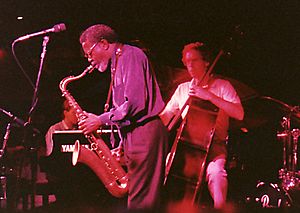Joe Henderson facts for kids
Quick facts for kids
Joe Henderson
|
|
|---|---|

Henderson with Neil Swainson and Jon Ballantyne
|
|
| Background information | |
| Born | April 24, 1937 Lima, Ohio, U.S. |
| Died | June 30, 2001 (aged 64) San Francisco, California, U.S. |
| Genres |
|
| Occupation(s) | Musician |
| Instruments | Saxophone |
| Years active | 1955–1998 |
| Labels |
|
| Associated acts |
|
Joe Henderson (born April 24, 1937 – died June 30, 2001) was an American jazz tenor saxophonist. He played the saxophone, a musical instrument. For over 40 years, Joe Henderson played with many famous American musicians. He also recorded music for well-known record labels. These labels included Blue Note, Milestone, and Verve.
Contents
Biography
Early Life and Music
Joe Henderson was born in Lima, Ohio. He was one of 14 children in his family. His parents, Dennis and Irene, and his older brother James T. encouraged him to study music. Joe later dedicated his first music album to them. He thanked them for being so supportive when he was young.
Joe was interested in drums, piano, saxophone, and writing music. Two local piano teachers, Richard Patterson and Don Hurless, taught him about the piano. He loved his brother's record collection. A drummer named John Jarette told Joe to listen to jazz greats. These included Lester Young, Stan Getz, Dexter Gordon, and Charlie Parker. Parker became his biggest inspiration. Joe learned to play the saxophone in high school. He also wrote many songs for his school band.
By age 18, Joe was playing jazz in Detroit. He joined jam sessions with famous musicians from New York City. He studied flute and bass at Wayne State University. He also improved his saxophone playing and songwriting. His teacher, Larry Teal, helped him a lot. In 1959, he started his first music group. His college friends included Yusef Lateef and Herbie Hancock.
Starting His Career
In 1960, Joe Henderson joined the U.S. Army. He spent two years serving his country. First, he won a talent show at Fort Benning. Then, he was chosen for a world tour. This tour was to entertain soldiers. In Paris, he met jazz musicians Kenny Drew and Kenny Clarke.
After leaving the Army in 1962, Joe moved to New York. He met trumpeter Kenny Dorham, who became a great guide for him. One evening, they saw Dexter Gordon playing at Birdland. Gordon invited Joe to play with his band. Joe happily accepted the chance.
Joe's early music had a strong hard bop jazz style. But he also played bebop, R&B, Latin, and experimental jazz. Soon, he joined Horace Silver's band. He played a famous saxophone solo on their hit song "Song for My Father". After leaving Silver's band in 1966, Joe played with many different groups. He also led a big band with Kenny Dorham.
Blue Note Years
From 1963 to 1968, Joe Henderson recorded for Blue Note. He appeared on nearly 30 albums. Five of these albums were released under his own name. His music ranged from traditional jazz to more experimental sounds. Some of his own albums were Page One (1963) and Inner Urge (1966).
He also played on many important albums for other leaders. These included Horace Silver's Song for My Father. He also played on Herbie Hancock's The Prisoner. Joe was also featured on Lee Morgan's popular album The Sidewinder. He worked with pianist Andrew Hill and drummer Pete La Roca.
In 1967, Joe briefly played with Miles Davis's band. This group included Herbie Hancock and Wayne Shorter. However, they never recorded any music together. Joe's ability to play many different styles became very clear.
Milestone Records and New Sounds
In 1967, Joe Henderson signed with Milestone. This started a new part of his career. He led a group called the Jazz Communicators with Freddie Hubbard. Joe also played on Herbie Hancock's Fat Albert Rotunda. During this time, Joe began to try new things. He experimented with jazz fusion, which mixes jazz with other music styles. He also used new recording techniques and electronic sounds.
Some of his song and album titles showed his interest in social issues. These included Power to the People and In Pursuit of Blackness.
After a short time with the band Blood, Sweat & Tears in 1971, Joe moved to San Francisco. He also started teaching music.
Later Career and Legacy
Throughout the 1980s, Joe Henderson mostly led his own bands. He was a talented composer who wrote many songs. He started focusing on playing classic songs and his own older music. In 1986, Blue Note released State of the Tenor. These albums showed Joe playing with just a bass and drums. He often played Thelonious Monk's "Ask Me Now" as a special ballad.
Later, the Verve record label signed him. They promoted his music widely. His 1992 album, Lush Life: The Music of Billy Strayhorn, was a big success. It was popular with both listeners and music critics. After this, he released tribute albums to Miles Davis and Antonio Carlos Jobim. He also recorded his version of the opera Porgy and Bess.
Joe Henderson passed away on June 30, 2001, in San Francisco, California. He was 64 years old. He had been battling a long illness that affected his breathing, which led to heart problems.
Discography
See also
 In Spanish: Joe Henderson para niños
In Spanish: Joe Henderson para niños

